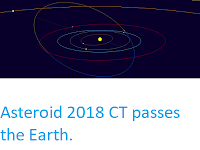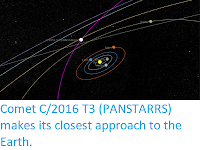Asteroid 2015 SY16 passed by the Earth at a distance of about 8 072 000
km (21.0 times the average distance between the Earth and the Moon, or 5.40% of the distance between the Earth and the Sun), at about 5.20 pm
GMT on Tuesday 13 February 2018. There was no danger of
the asteroid hitting us, though were it to do so it would have
presented a significant threat. 2015 SY16 has an estimated
equivalent
diameter of 86-270 m (i.e. it is estimated that a spherical object
with
the same volume would be 86-270 m in diameter), and an object at the upper end of this range would be predicted to be capable of
passing through the Earth's
atmosphere relatively intact, impacting the ground directly with an
explosion that would be about 47 000 times as powerful as the
Hiroshima
bomb. Such an impact would result in an impact crater about 4 km
in
diameter
and devastation on a global scale, as well as climatic effects that
would last years or even decades.
The calculated orbit of 2015 SY16. Minor Planet Center.
2015 SY18 was discovered on 23 September 2015 by the University of Hawaii's PANSTARRS
telescope on Mount Haleakala on Maui. The designation 2015 SY16 implies
that it was the 424th asteroid (asteroid Y16) discovered in the second
half of September 2015 (period 2015 S).
2015 SY16 has a 506 day orbital period and an eccentric orbit
tilted at an angle of 5.26° to the plane of the Solar System, which
takes it from 0.62 AU from the Sun (i.e. 62% of he average distance at
which the Earth orbits the Sun, somewhat less the distance at which the
planet
Venus orbits the Sun) to 1.86 AU from the Sun (i.e. 186% of the
average distance at which the Earth orbits the Sun, and more distant from the Sun than the planet Mars). It is therefore
classed as an
Apollo Group Asteroid (an asteroid that is on average further from the
Sun than the Earth, but which does get closer). This means that close
encounters between the asteroid and Earth are extremely common, with the
last having occurred in August 2015 and the next predicted
in June 2022. As an asteroid probably larger than 150 m in diameter
that occasionally comes within 0.05 AU of the Earth, 2015 SY16 is also
classified as a Potentially Hazardous Asteroid.
2015 SY16 also
has frequent close encounters with the planets Venus, which it is
thought to have last passed in July 2015, and is next predicted to
pass in February 2021, and Mars which it last came close to in July 1951
and
is next predicted to pass in April 2019). Asteroids
which make close passes to multiple planets are considered to be in
unstable orbits, and are often eventually knocked out of these orbits by
these encounters, either being knocked onto a new, more stable orbit,
dropped into the Sun, knocked out of the Solar System or occasionally
colliding with a planet.
See also...
Follow Sciency Thoughts on Facebook.







